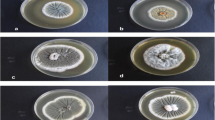Abstract
Effects of temperature on vegetative growth on a semi-synthetic medium of 22 isolates of Metarhizium anisopliae and 14 isolates of M. flavoviride were determined. The majority of isolates of both species grew between 11 and 32°C; several isolates grew at 8 and 37 °C. None of the isolates grew at 40 °C. Relative growth rate, calculated from the maximum growth rate for each isolate, was significantly affected by temperature and isolate, with significant isolate * temperature interactions. The maximum absolute growth rates among the isolates ranged from 2.5 mm to 5.9 mm/day. Optimal temperatures were generally between 25 and 32 °C with several isolates exhibiting optimal growth at temperatures as high as 32 °C. Overall, relative growth rates were greater in isolates of M. anisopliae than M. flavoviride at temperatures of 25 °C or lower; conversely mean relative growth rates were greater in M. flavoviride than M. anisopliae at temperatures higher than 25 °C. However, the two most cold tolerant isolates at 8 °C were M. flavoviride and the three most heat tolerant at 35 °C were M. anisopliae. Since temperature growth responses varied considerably between isolates, strain selection according to thermal tolerance may be warranted when choosing a strain for development as a microbial control agent.
Similar content being viewed by others
References
Carruthers RI, Robson DS, Roberts DW. In vivotemperature dependent development of Beauveria bassiana(Deuteromycotina: Hyphomycetes) mycosis of the European corn borer, Ostrinia nubilalis(Lepidoptera: Pyralidae). J Invertebr Pathol 1985; 46: 305-311.
Benz G. Environment. In: Fuxa JR, Tanada Y, eds. Epizootiology of Insect Diseases. New York, John Wiley & Sons, 1987: 177-214.
Ferron P, Fargues J, Riba G. Fungi as microbial insecticides against pests. In: Arora DK, Ajello L, Mukerjii KG, eds. Handbook of Applied Mycology. New York, Marcel Dekker, 1991, vol 2: 665-706.
Watson DW, Mullens BA, Petersen JJ. Behavioral fever response of Musca domestica(Diptera: Muscidae) to infection by Entomophthora muscae(Zygomycetes: Entomophthorales). J Invertebr Pathol 1993; 6: 10-16.
Boorstein SM, Ewald PW. Costs and benefits of behavioral fever in Melanoplus sanguinipesinfected by Nosema acridophagus. Physiol Zool 1987; 60: 586-595.
Carruthers RI, Larkin TS, Firstencel H. Influence of thermal ecology on the mycosis of a rangeland grasshopper. Ecology 1992; 73: 190-204.
Inglis GD, Johnson DL, Goettel MS. Effects of temperature and thermoregulation on mycosis by Beauveria bassianain grasshoppers. Biol Control 1996; 7: 131-139.
SAS Institute Inc. SAS/STAT Users' Guide. Cary, NC, SAS Institute Inc 1988; Version 6.03.
Fargues J, Maniania NK, Delmas JC, Smits N. Influence de la température sur la croissance in vitrod'hyphomycetes entomopathogè nes. Agronomie 1992; 12: 557-564.
Hall RA, Papierok B. Fungi as biological control agents of arthropods of agricultural and medical importance. Parasitology 1982; 84: 205-240.
Bateman RP, Carey M, Moore D, Prior C. The enhanced activity of Metarhizium flavoviridein oil formulation to desert locusts at low humidities. Ann Appl Biol 1993; 122: 145-152.
Inglis GD, Johnson DL, Goettel MS. Effect of bait substrate and formulation on infection of grasshopper nymphs by Beauveria bassiana. Biocont Sci Technol 1996; 6: 35-50.
Lomer CJ, Prior C, Kooyman C. Development of Metarhiziumspp. for the control of grasshoppers and locusts. In: Goettel MS, Johnson DL, eds. Microbial Control of Grasshoppers and Locusts. Memoirs Entomological Society of Canada (in press).
Prior C, Street DA. Strategies for the use of entomopathogens in the control of the desert locust and other acridid pests. In: Goettel MS, Johnson DL, eds. Microbial Control of Grasshoppers and Locusts. Memoirs Entomological Society of Canada (in press).
Author information
Authors and Affiliations
Rights and permissions
About this article
Cite this article
Ouedraogo, A., Fargues, J., Goettel, M. et al. Effect of temperature on vegetative growth among isolates of Metarhizium anisopliae and M. flavoviride . Mycopathologia 137, 37–43 (1997). https://doi.org/10.1023/A:1006882621776
Issue Date:
DOI: https://doi.org/10.1023/A:1006882621776




